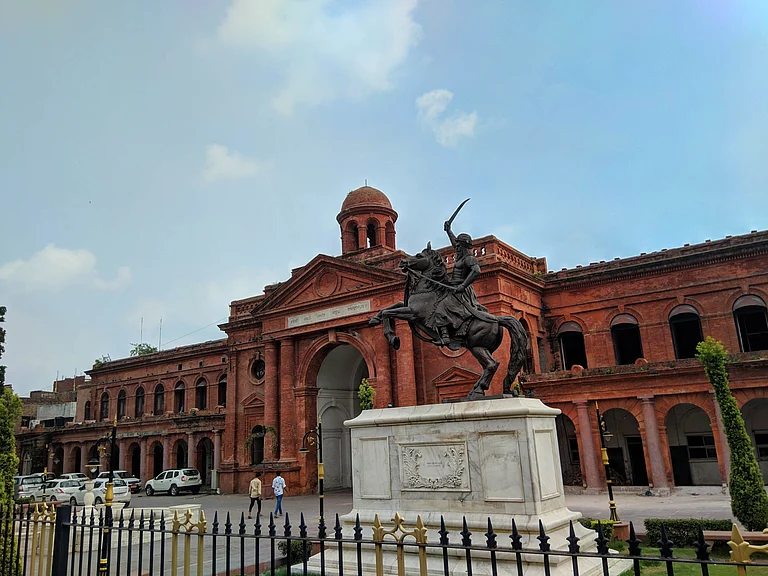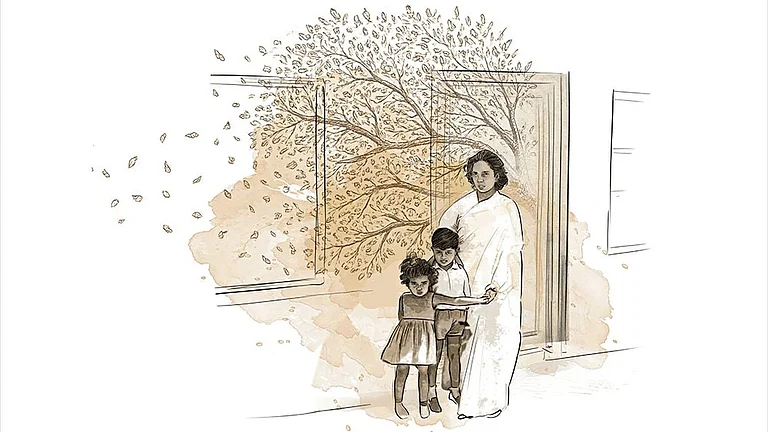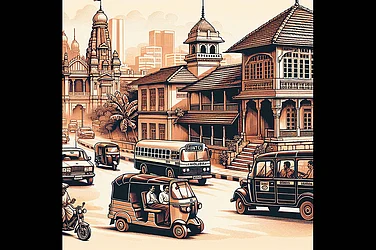
Kiran Desai’s new novel, The Loneliness of Sonia and Sunny spans the late 1990s and early 2000s.
The novel harks back to Desai’s 2006 Booker winner The Inheritance of Loss.
The Loneliness of Sonia and Sunny has been shortlisted for the Booker Prize.
Early in Kiran Desai’s new novel, The Loneliness of Sonia and Sunny, a character remarks, “Western psychology is no match for an Indian family. We are too slippery, we change shape, we don’t distinguish truth from lies–you can’t pin us down.” It’s this very malleability Desai maps in her luxuriously winding saga of displacement and remaking on a global stage. Spanning the late 1990s and early 2000s, the novel harks back to Desai’s 2006 Booker winner, The Inheritance of Loss. A sense of a generation passing, fraying houses, a keen eye for tension within India’s social classes, knotty dynamics between India and the West riddled with self-loathing and shame–both books share a spiritual fabric.
But The Loneliness of Sonia and Sunny is more richly alert to an idea of India as existing within and performing for a Western gaze. At the same time, Desai deconstructs this particular framing with her ensemble slipping in and out of geographically inflected models. Balancing wit and humour with precise, incisive observation, the novel continually lays bare both how the emigrant and the one staying behind are shaped by displacement all around. Therefore, identities, aspirations and insecurities remain in flux, tempering themselves as per specific arrivals and departures. As the gaze sweeps across in The Loneliness of Sonia and Sunny, agency and power swing vis-à-vis location and hierarchy.

The Allahabad-born Sonia Shah complains of loneliness while stuck in snowy Vermont for her creative writing graduate programme. Much of the novel dovetails the act of writing, how an artist hews from life. Sonia’s personhood, her artistic self, is left shattered by her toxic ex, the reputed painter, Ilan, who is more than three decades older. He strips away her voice, sucking dry life and re-routing it into his art. Trauma tails Sonia. Desai doubles down on surreal metaphors despite Sonia’s internalised unease around them. Sonia’s anxieties are manifest in a ghost hound, a mysterious roving eye wherever she lands, Goa or Italy. These visions trigger uncertainty in her. She struggles to define herself in Ilan’s stormy wake. Increasingly, she panics over her stories leaning into exotic allure. Desai’s own anxieties, as reiterated in past interviews, over her work’s perception between Western and Indian audiences play into the picture. In a playful riff, one of her tales resembles Desai’s debut, Hullabaloo in the Guava Orchard (1998). Ilan dismisses it as “oriental nonsense”, pushing her towards realism. He dictates how she should write so that India isn’t patronised in her work, even while he belittles her. But she’s torn:
“Wouldn’t Sonia need to live a life to tell a tale? Yet to write meant stepping out of life, isolating yourself. If you tried to balance the two, wouldn’t you be living a life for the sole purpose of creating a fictional life, not one that would take its natural course, but one that would be bending and shaping toward a secret purpose? You wouldn’t make a choice for happiness, but for an escapade you might relate”.
Throughout, Desai teases parallels with her own journey in whittling this 670-pager’s shape out of colossal, ranging material. Life and art begin to exert its strange osmosis. Ilan cautions her against reading Anna Karenina for it may “become a mirror” to her fate. How much of our selves are informed and moulded by the art we consume? Characters in the novel almost refuse to be seen in isolation to books in their bags, or even music, as is the case with Sonia’s father. Elsewhere, Junichiro Tanizaki’s shadow theory recasts the Eastern longing for the white ideal. Returning heart-smashed to India, Sonia chances across Sunny Bhatia, a journalist working with Associated Press. Their families are neighbours. Long after a failed marriage proposal, the two drift back to each other, abandoned by love and increasingly unmoored within America. The shadow theory invokes the unease Sonia and Sunny have as storytellers and journalists reporting on India from within. Even as Sonia tries to write an article on Indian kebabs, she realises, “this was India. You might try to write a slender story, but it inevitably connected to a larger one. The sense could never be contained.”
Sonia wonders, “Could she write all the love stories she knew? Would these stories intersect and make a book? How would they hold together? How to trust herself to do her part to sustain what existed beyond her vision? What if she stepped back to survey what she had wrought and saw that it lay in incoherent pieces?”
Vaster forces corral the tale of the couple. The past, both familial and historical, insists, while Sonia and Sunny pursue to remake lives without being accented by race or nationality. Some major events bring noticeable undercurrents, like the Babri Masjid demolition, while others like the fall of the Twin Towers dangle forthcoming impact.
Loneliness and yearning shift shape, connoting varying things for different individuals. Desai refracts it through artistic, political, existential and transcendental dimensions. What opens as a question of Sonia’s private loneliness melds into a saga of communities, nations, races and classes, each afflicted by peculiar alienations. Shadowed by spiritual restlessness, Sonia’s German grandfather wandered deep into the Himalayas, vanishing as if consumed by the landscape. His talisman engraved with a faceless demon, Badal Baba, trails Sonia through luck and terror. It unlocks the uncanny lurking within the folds of the novel, calling forth an epic scale, a history in momentum. The grandfather sublimates himself in his paintings, whereas Ilan primes every artwork to fuel his aggrandising ego. Sunny’s long-widowed mother, Babita, initially whets her loneliness in hovering over his life from afar. An Albanian bartender Sunny meets, whose family lived through tyranny and surveillance, extols unwatched solitude as “rich and nourishing”, not loneliness. This also qualifies for Sonia’s mother, Seher, who escapes a long-suffering marriage and builds a new life in Landour. “There are worse things than loneliness; it could mean abiding peace,” Seher assures her daughter trapped in a future-less Delhi life with her father. Sonia’s aunt, Mina Foi, has a fresh lease of life at a convent with newfound purpose.
Loneliness and yearning shift shape, connoting varying things for different individuals. Desai refracts it through artistic, political, existential and transcendental dimensions.
In this sprawling, globalised present, differences whittle away as well as reinstate themselves in endless migration. For the duo, home and the world are a constant straddling between fleeing and falling back on families. Sunny can barely be around his controlling mother whereas Sonia is forced into shelter in her estranged parents. Sunny’s relationship with an American girlfriend is one of elaborate pre-empting gestures, both hyper-aware of inter-racial negotiations. It’s a complex dance of performance and masking, both “failing to keep their arguments personal, or respectful to their individual beings.”
Sunny and Sonia come from privileged families that veer to ruin but are never entirely vulnerable. At times, they wilfully sever themselves from their parents’ misfortunes. Sonia suffers upsetting situations, but financially sails through. These young people can afford to jet off to Italy. Despite her graduate programme in Vermont leading her nowhere, Sonia can rely on a family friend to guarantee her a magazine gig in India. This reduces stakes in the narrative. Sonia’s story idea gets approved so she can rendezvous with Sunny in Goa. Yet, Desai also warily punctures any notion a higher social class gives women safe mobility. Similarly, a place holds clashing implications across generations, social groups and classes. Desai chips through Goa’s idyll to flash menace, its hardened conservatism. The Goa that becomes party to the Sonia-Sunny romance is both terror and hesitant home for women away from their families’ orbit. Desai keeps the novel expansive and open to contradictions, armed with characters who surprise and charm in equal measure.
Occasionally, The Loneliness of Sonia and Sunny chafes at its own giddy excess, struggling to situate and condense multiple histories, threads and sub-plots all unleashed in wild, ecstatic, seething motion. The immigrant experience fractures into many subsets of ambivalence. Contentions with cosmopolitan dislocations run rife through the novel. Sunny oscillates between embracing and withdrawing from a “person of colour” label. Is it reductive, or its erasure “letting white people swallow him whole”? Sunny is conscious of the distancing, the power tussle existing among two brown people in a white space. The richer of the two would be happier if the other didn’t exist: “better to be one Indian than two Indians”.
However, leaps of ambition don’t always work in the novel’s favour. The Loneliness of Sonia and Sunny infuses its bagginess with defiance that also teeters into overconfidence. Given the scale of this epic, a certain unevenness is only inevitable. The loose-limbed storytelling, despite fluidity and verve, takes on an affectedly nostalgic lens in class-riven exchanges. For all the joys to be found in Desai’s orchestration of rabble-rousing and bitterness and jealousies within and between families and neighbours, including warring over a cook, it’s hard to shake off weariness in how she positions the lower social classes.
The novel’s forays into the surreal and gothic carve a vividly nightmarish subterranean world, but Desai leads them to a neat, hasty resolution. All of Sonia’s inner churn finds a calming key in Sunny’s interventions. Desai enacts dreamlike rites to bring about catharsis and freedom from trauma and deep emotional scars. These passages are disorienting and sensory, but also abruptly geared to necessitate the couple’s togetherness. But this doesn’t stifle the utter beauty, the dawning poise in reconciliation with art and between long-split people that radiate through the final few pages. Sonia grows to reflect, “maybe when reality shifted shape, a writer should let it shift. If she scattered her being into an ocean of stories, could they, like waves, bring her to another shore?” In The Loneliness of Sonia and Sunny, Kiran Desai makes these renewing tides of art and identity out of fraught, uncertain journeys. From splintered unwavering in a freshly globalised world’s chaos and myriad ruptures, Desai guides us, with carefully wrought lightness and levity, towards some form of resilience. This is a lavishly enthralling return for Desai.
Debanjan Dhar is a film fest-junkie & is fascinated by South Asian independent cinema.
MORE FROM THIS ISSUE
This story appeared as Atlas Of The Heart in Out of Syllabus, Outlook’s November 1 issue, which explored how the spirit of questioning, debate, and dissent—the lifeblood of true education—is being stifled in universities across the country, where conformity is prized over curiosity, protests are curtailed, and critical thinking is replaced by rote learning, raising urgent questions about the future of student agency, intellectual freedom, and democratic engagement.

































